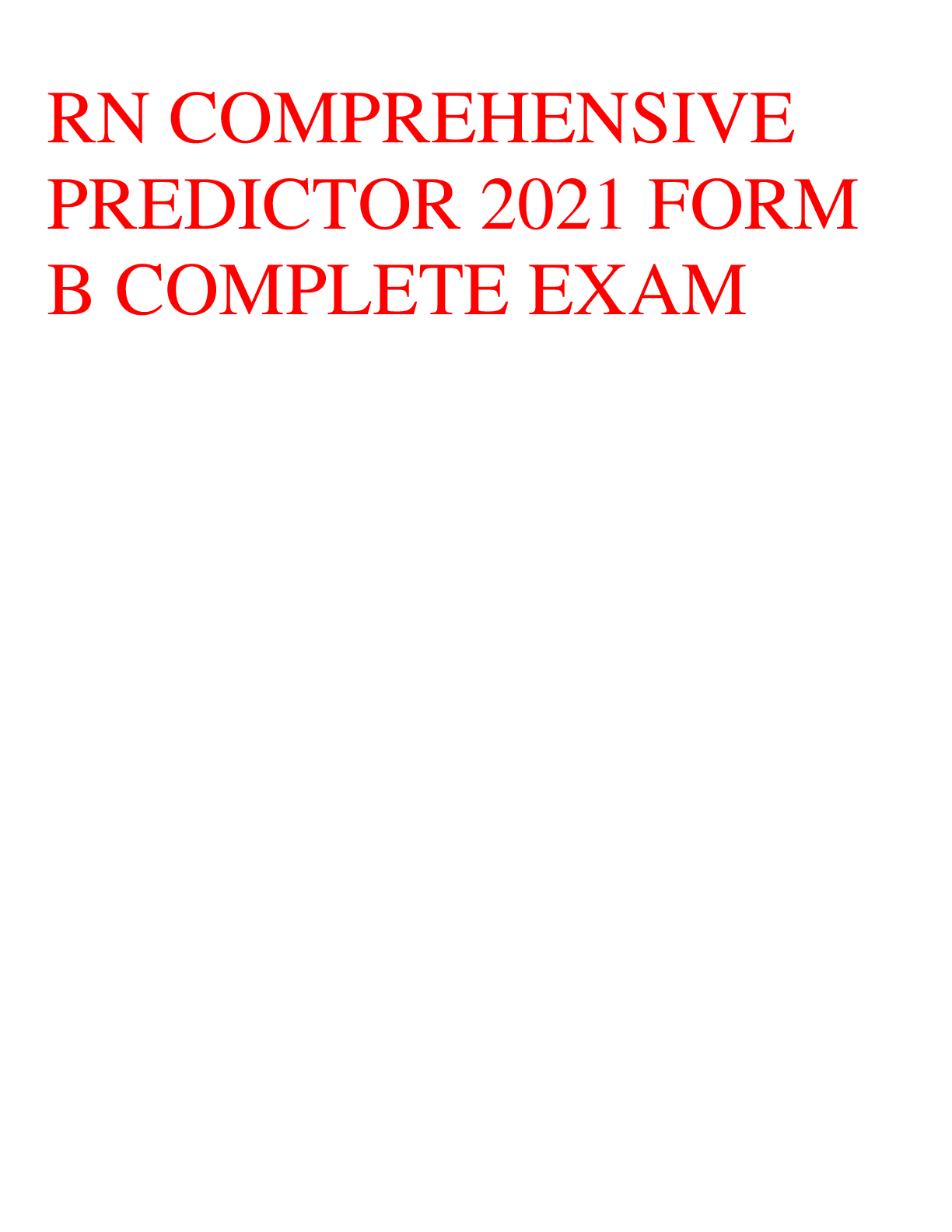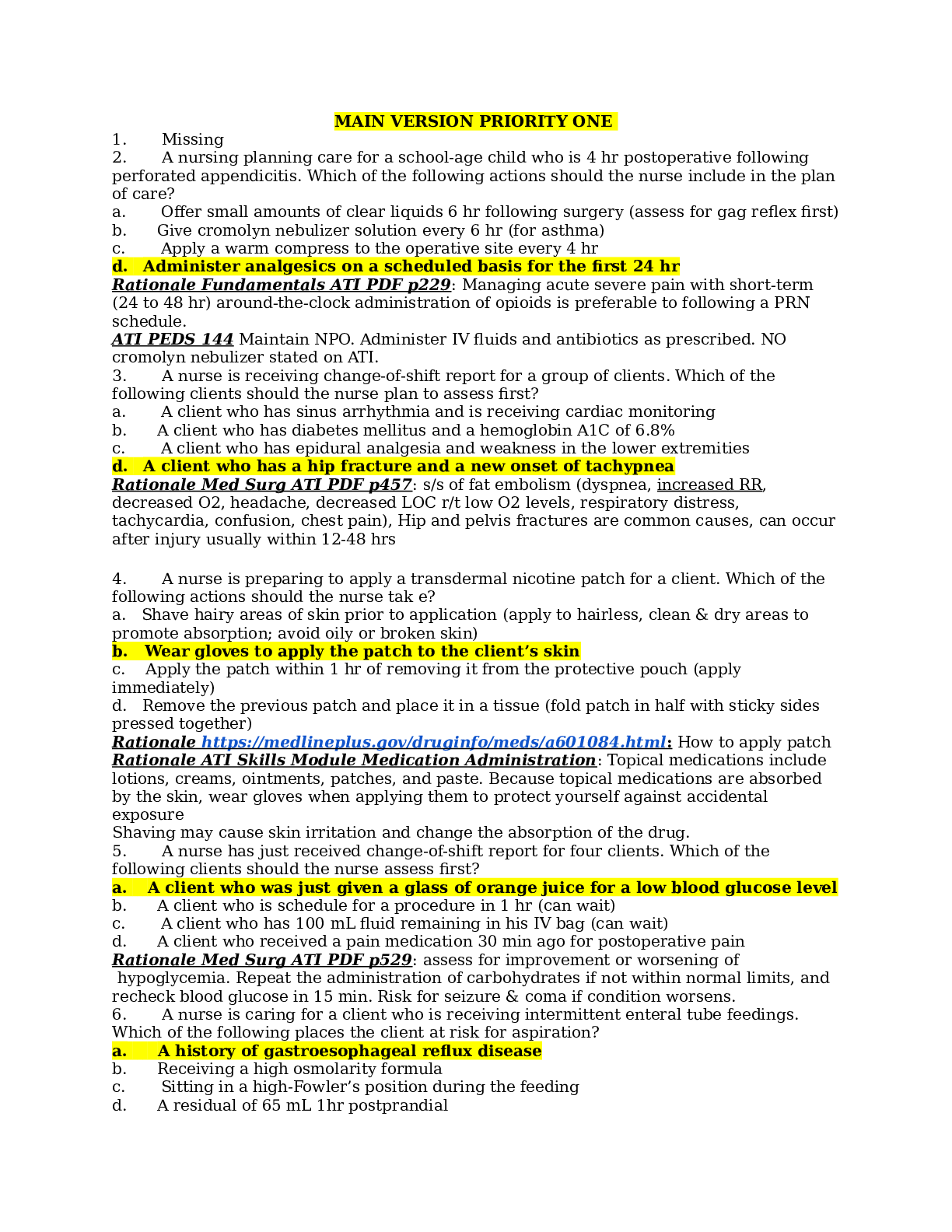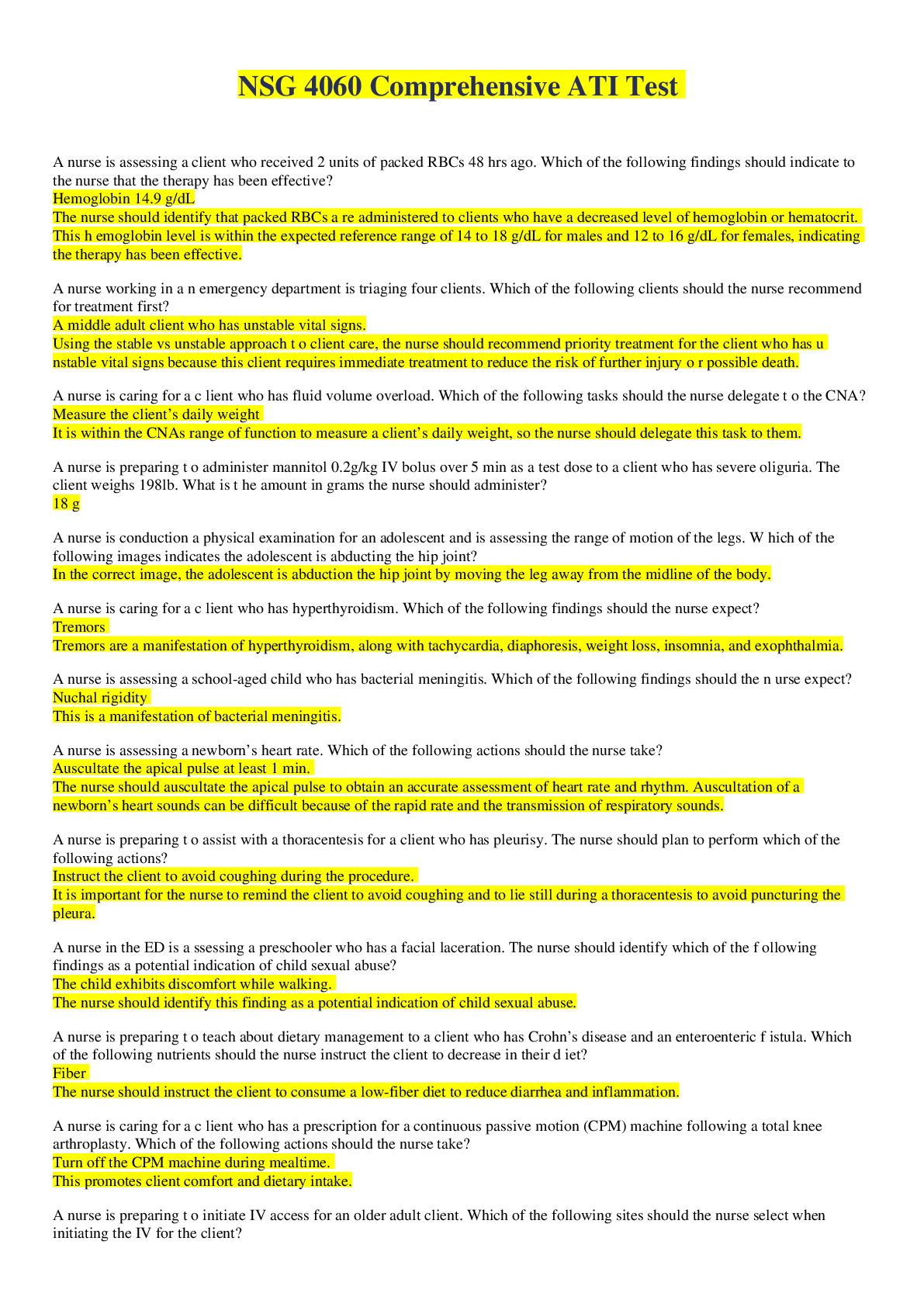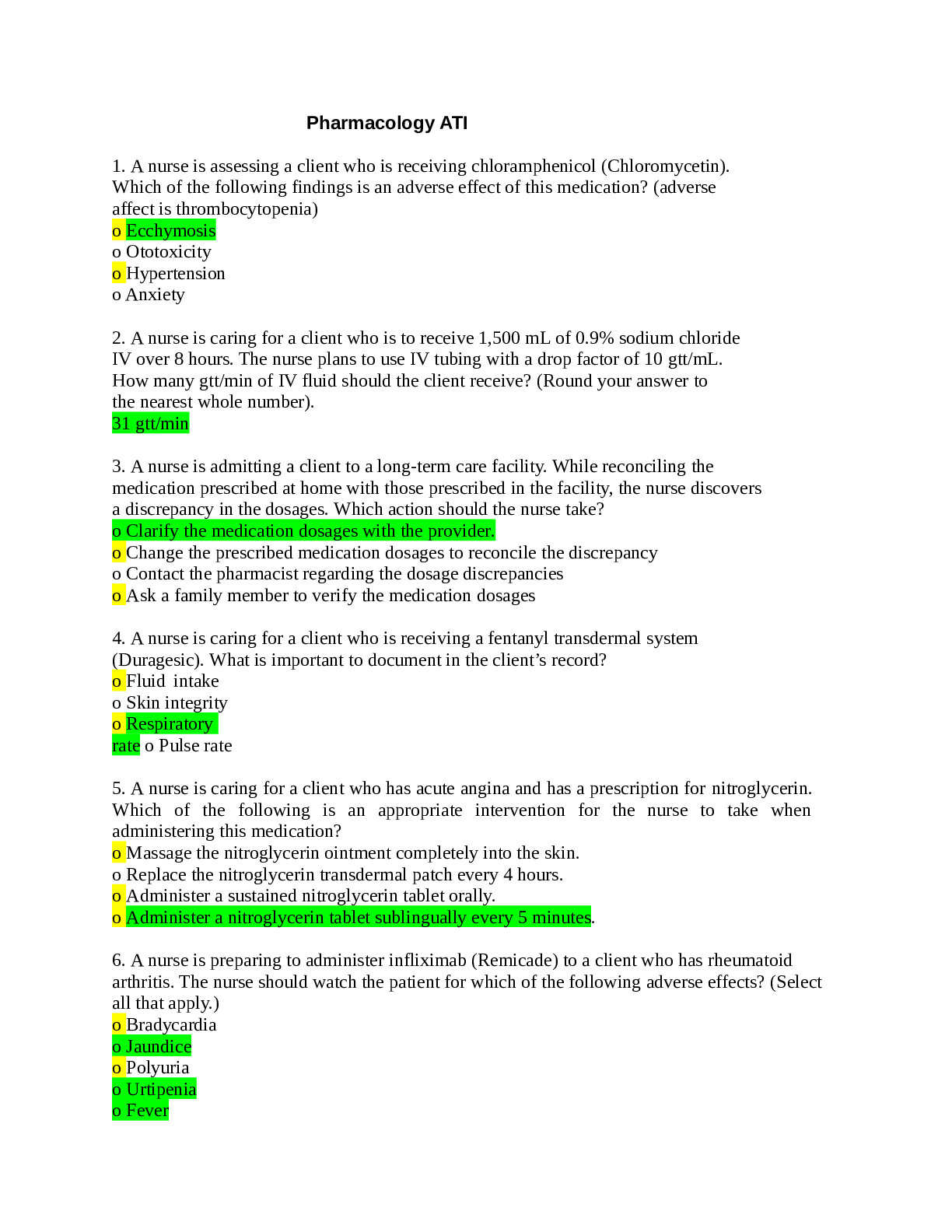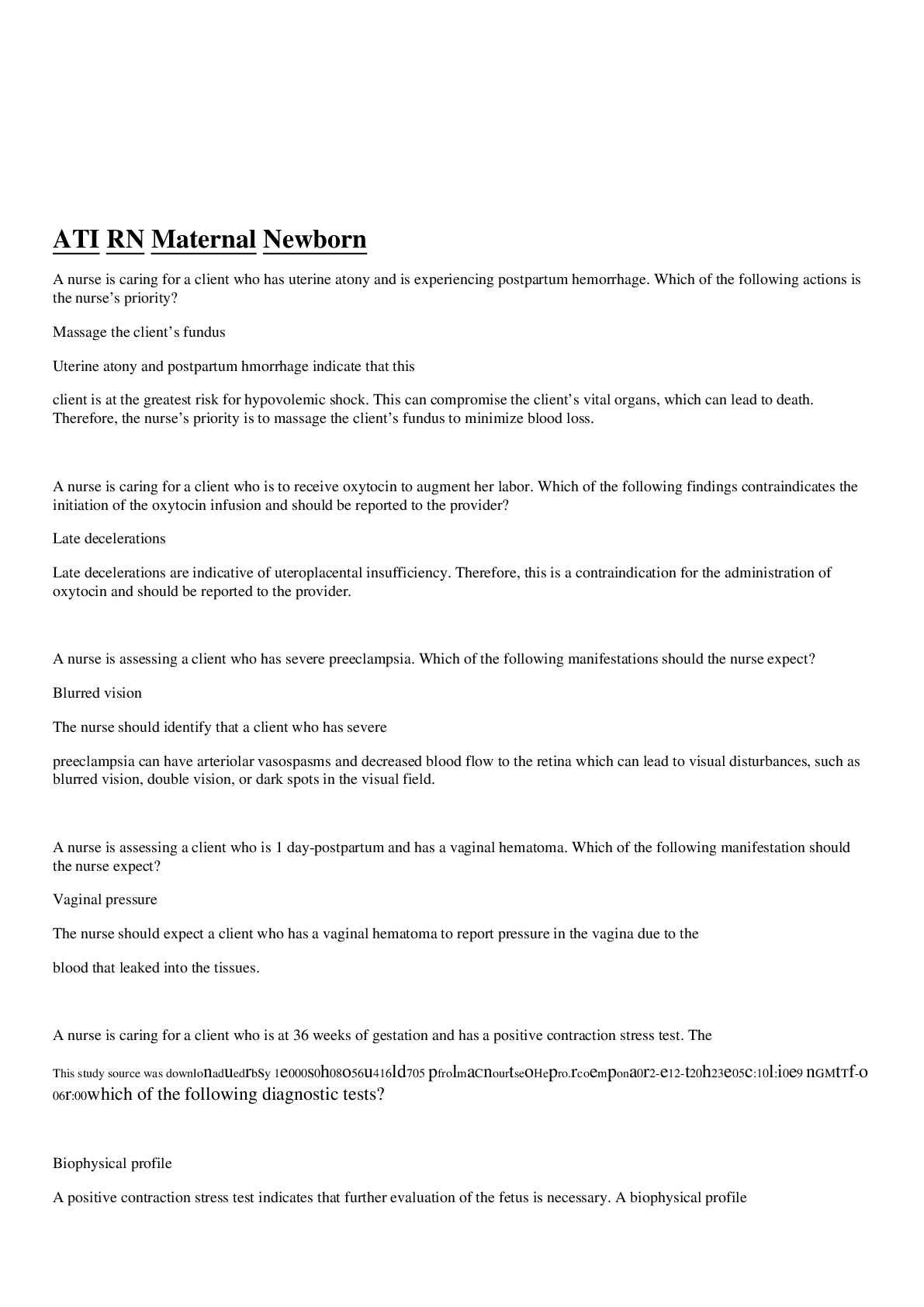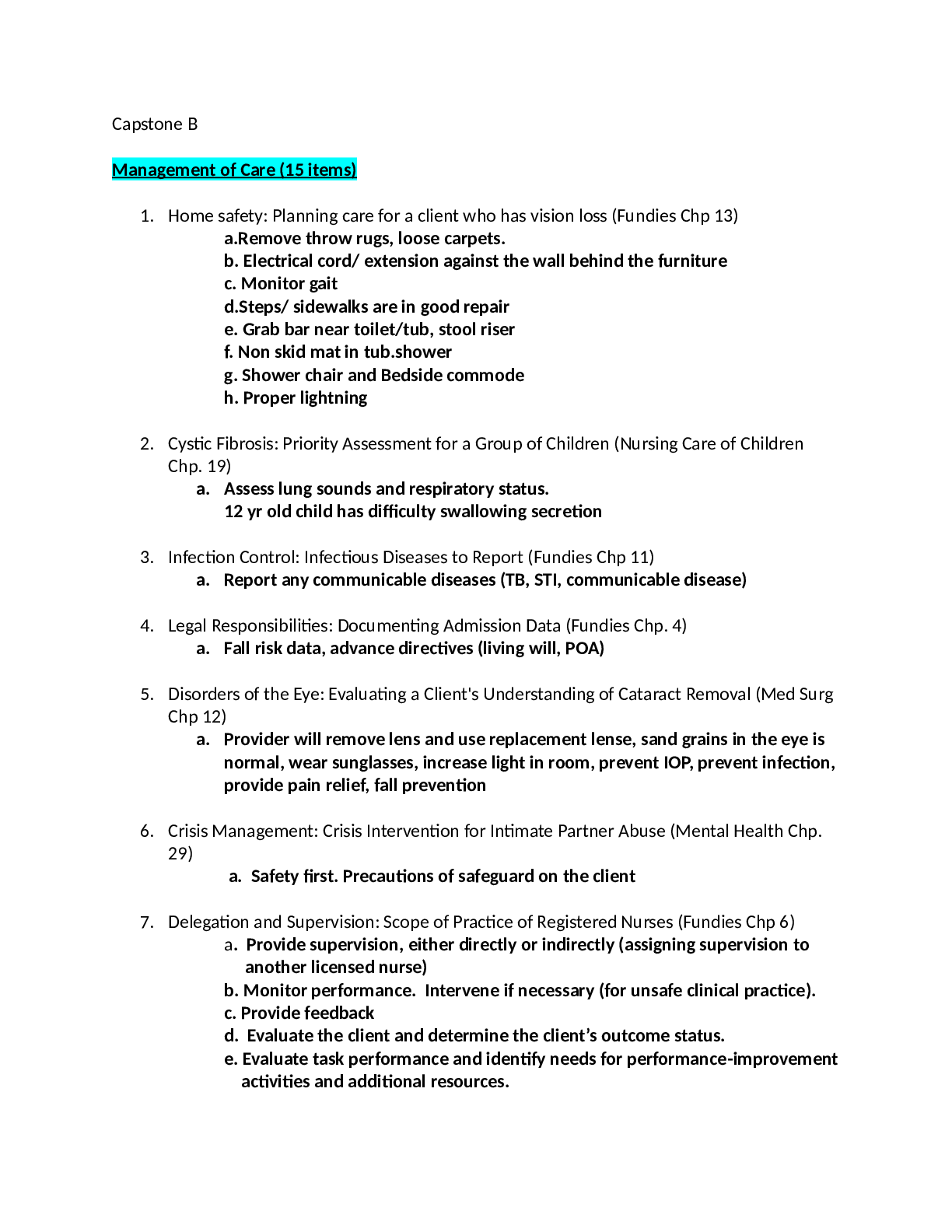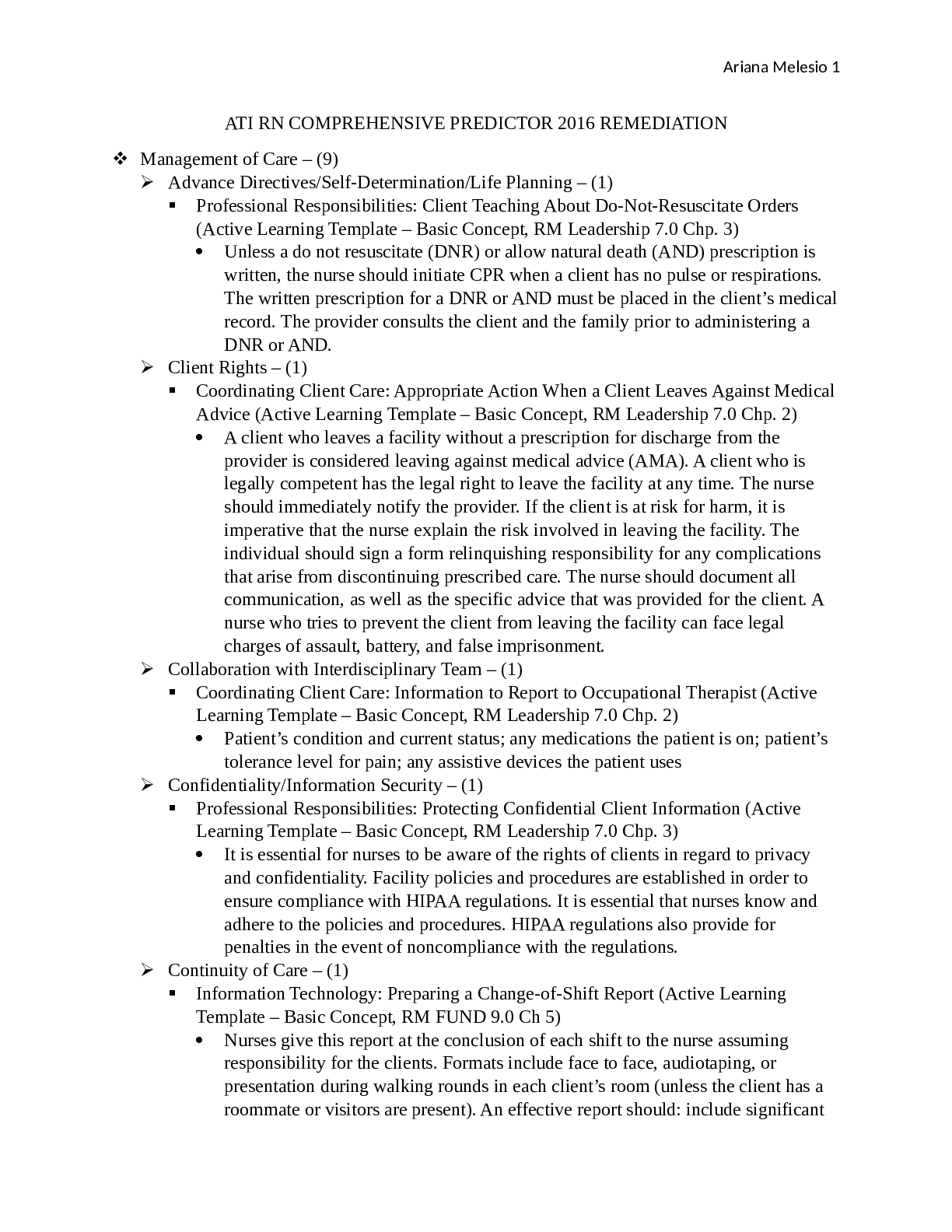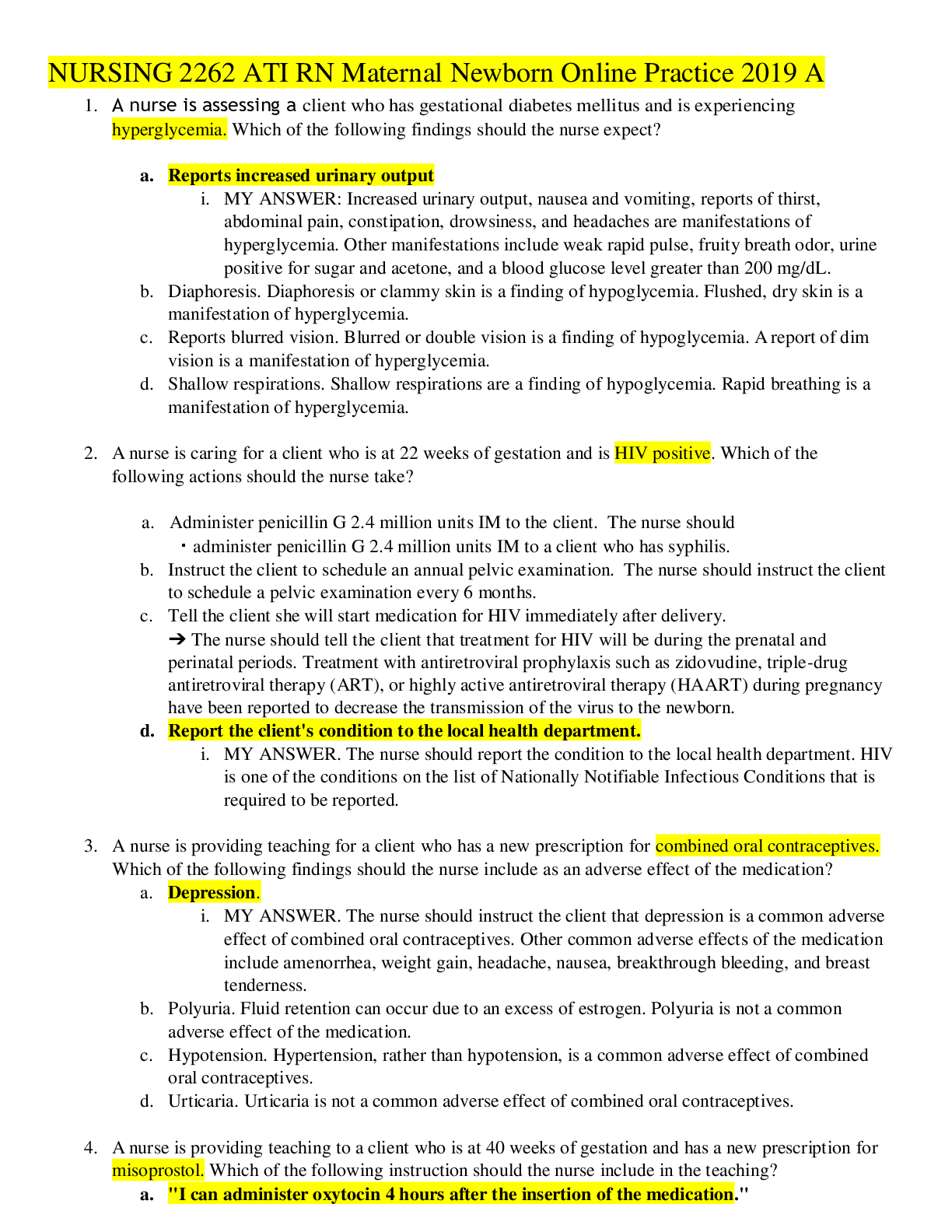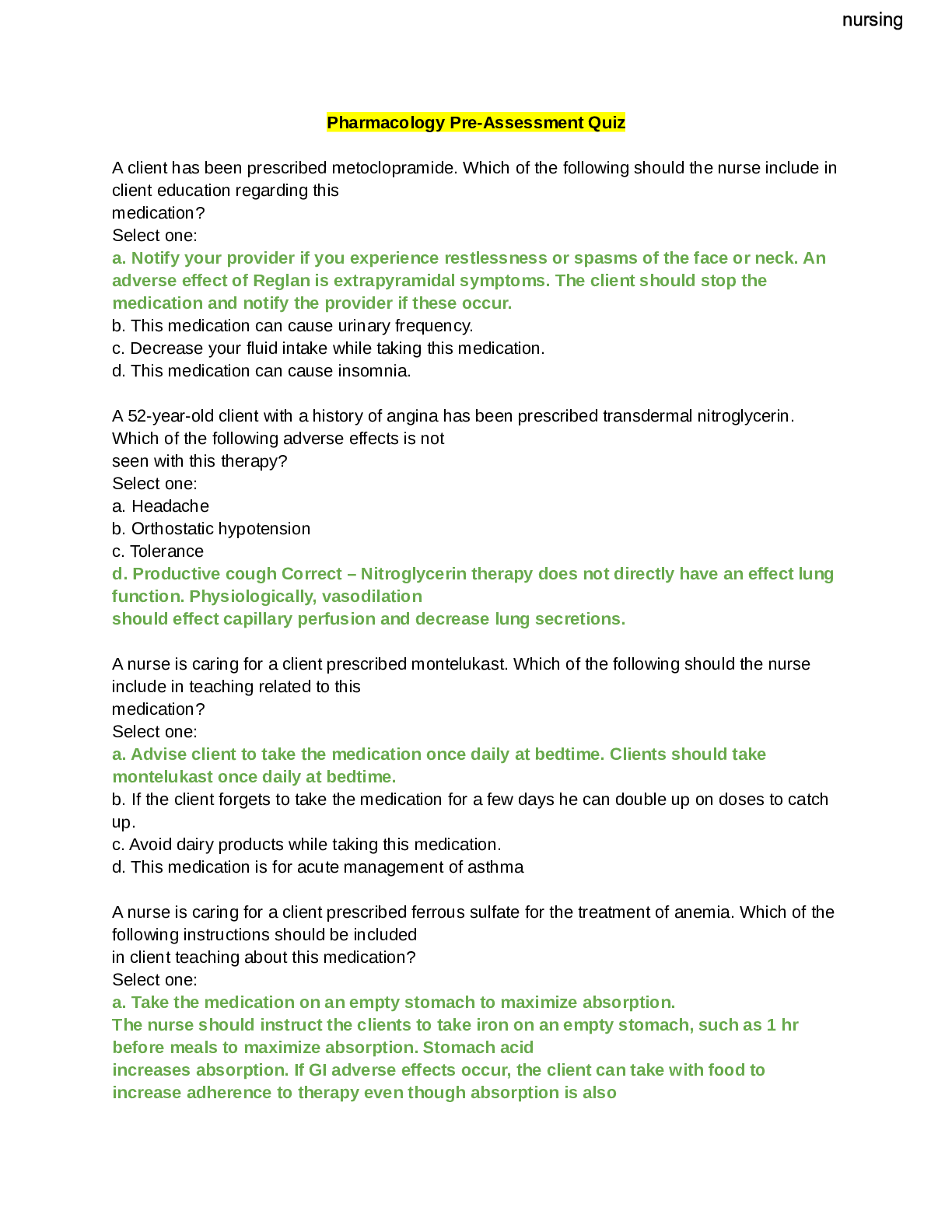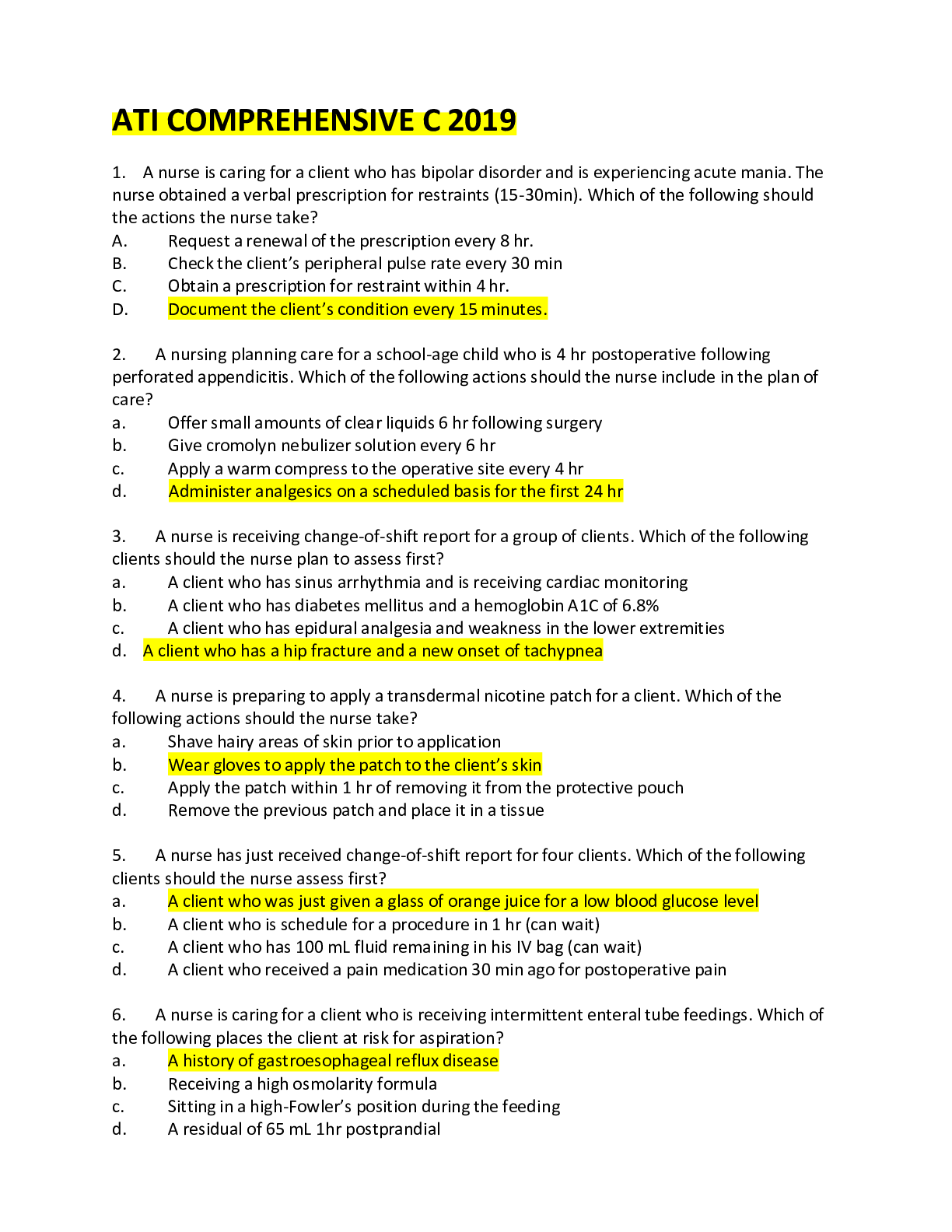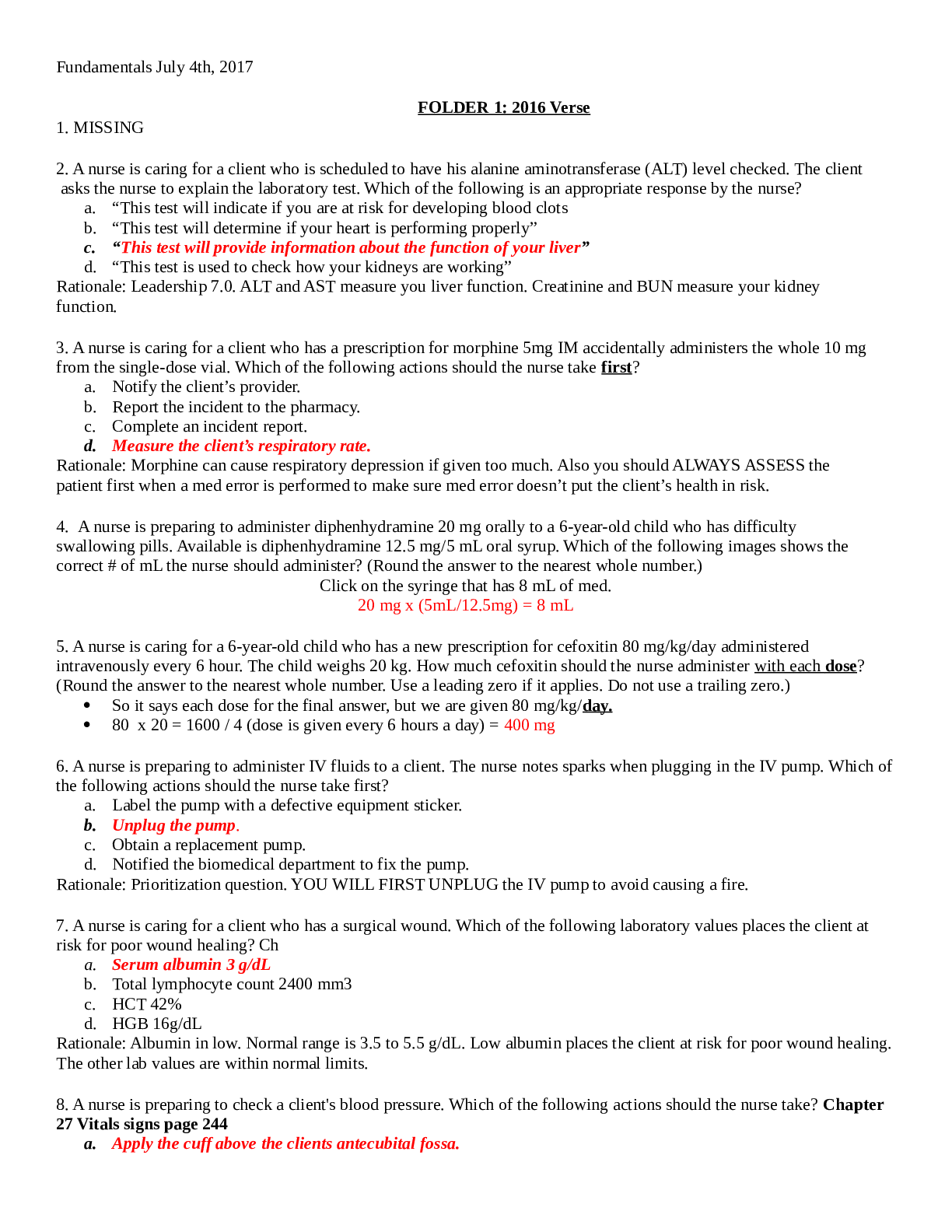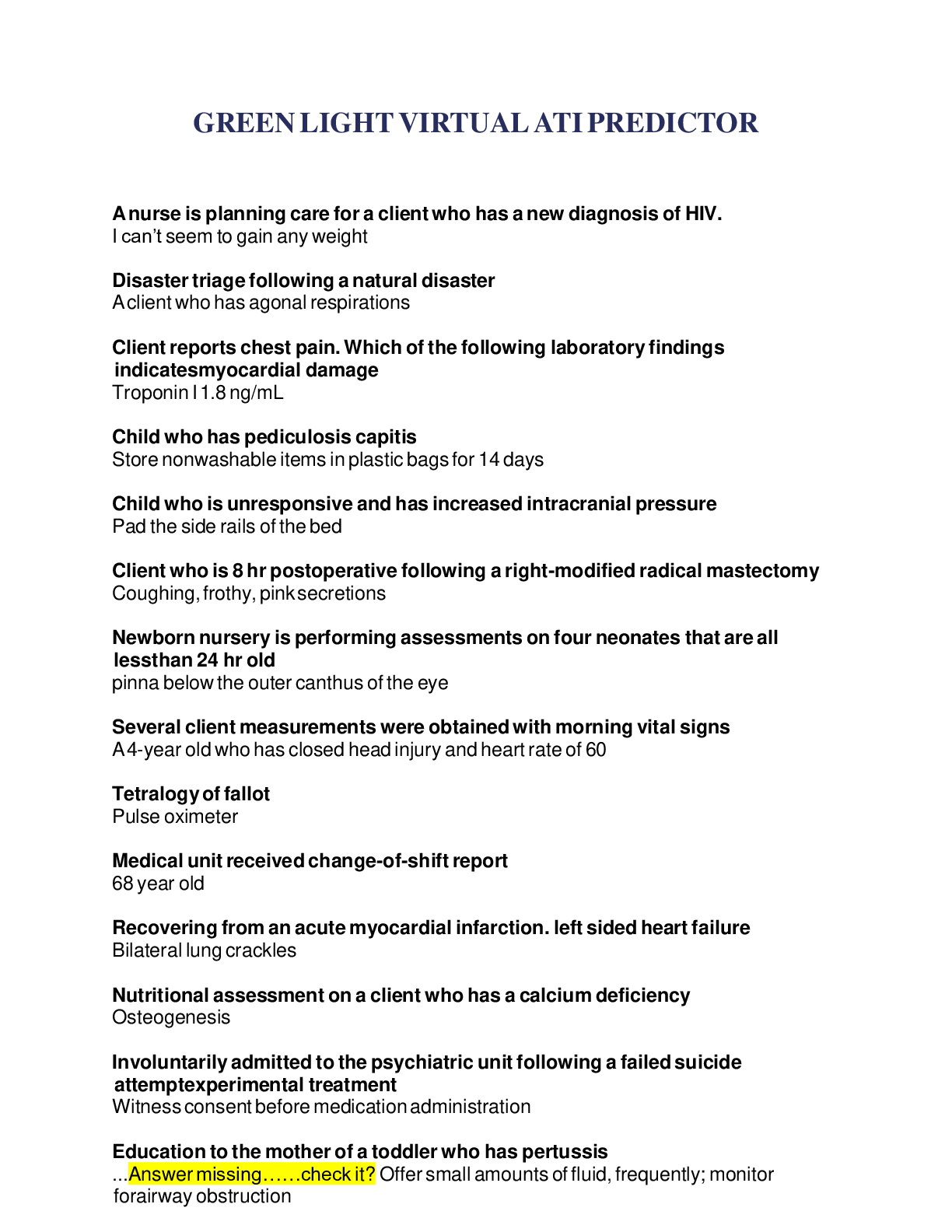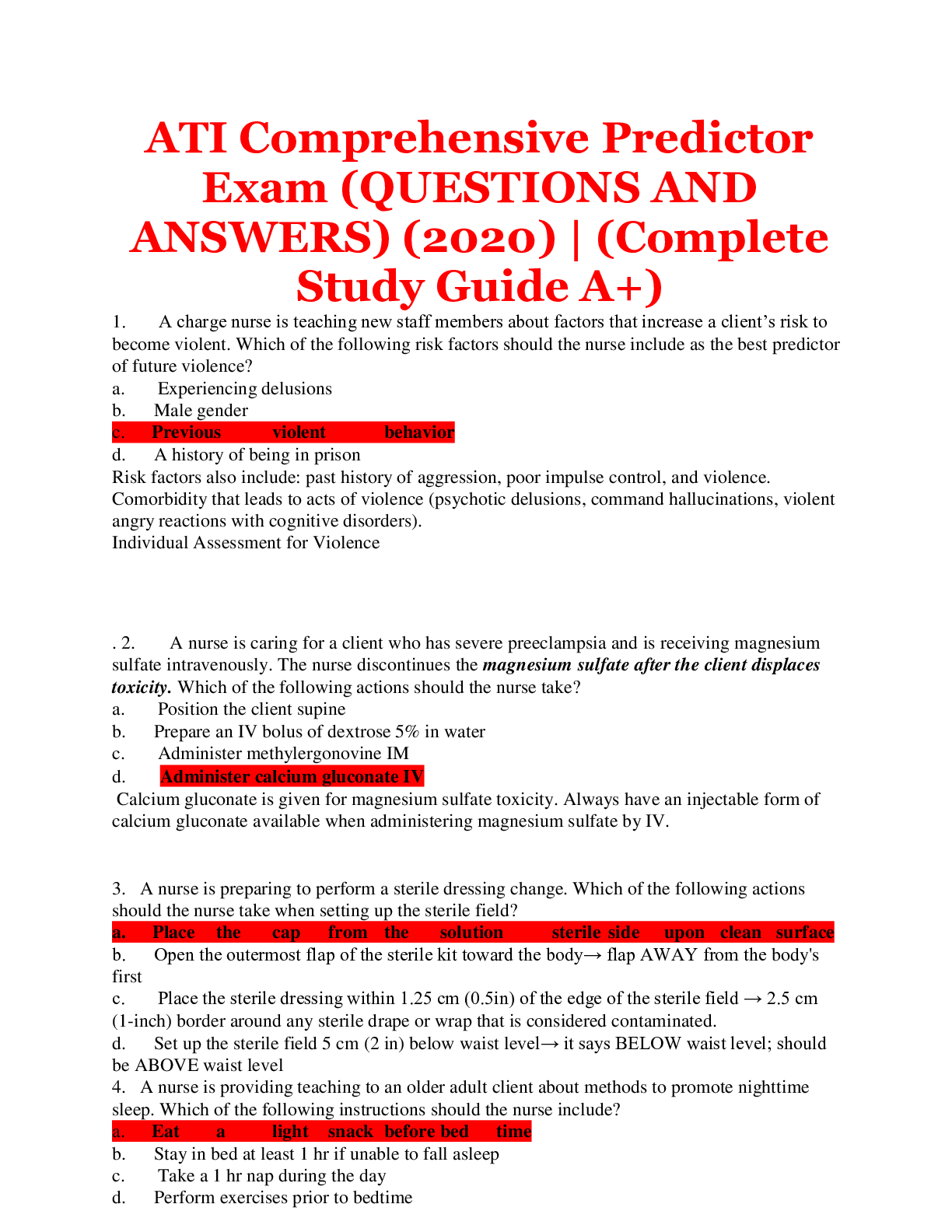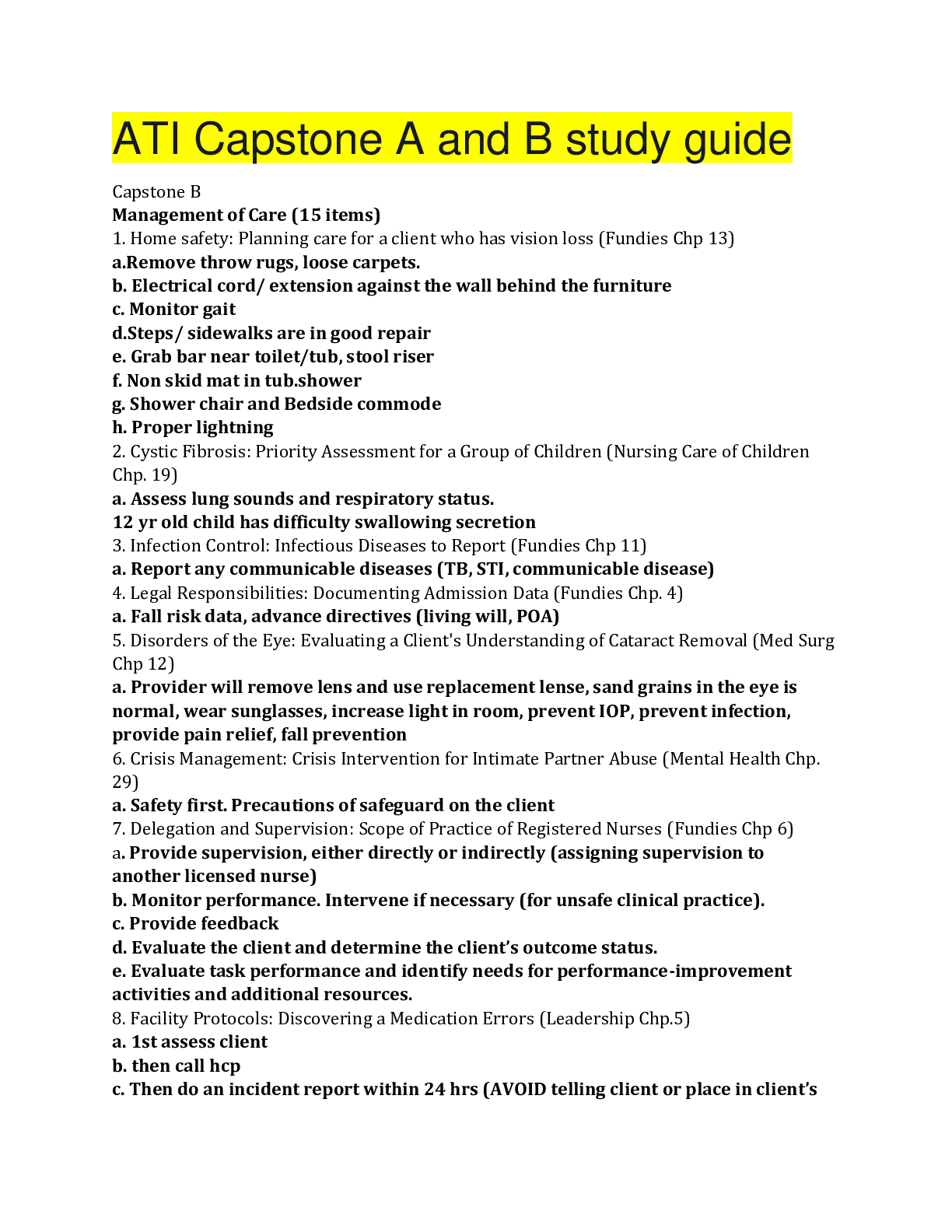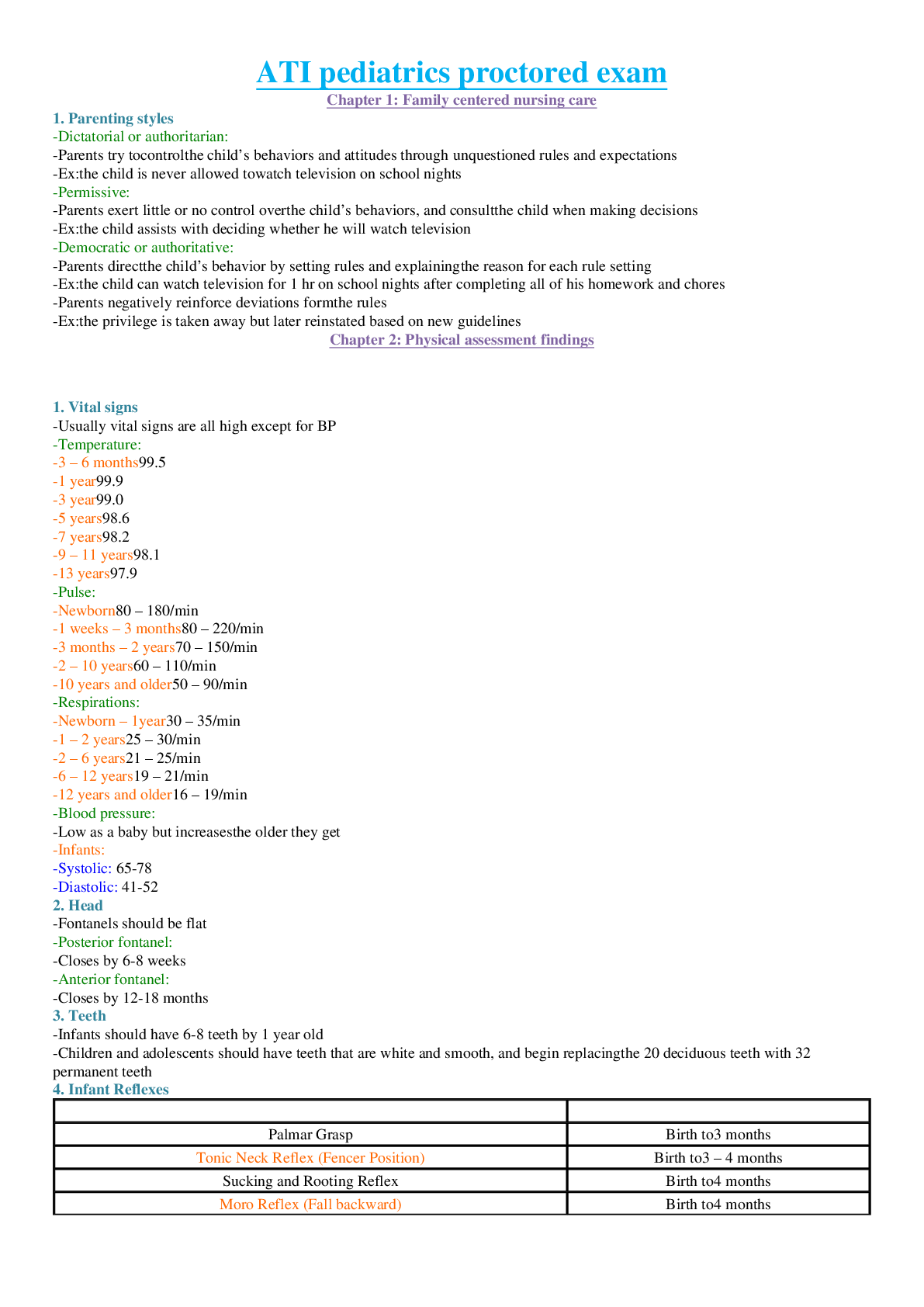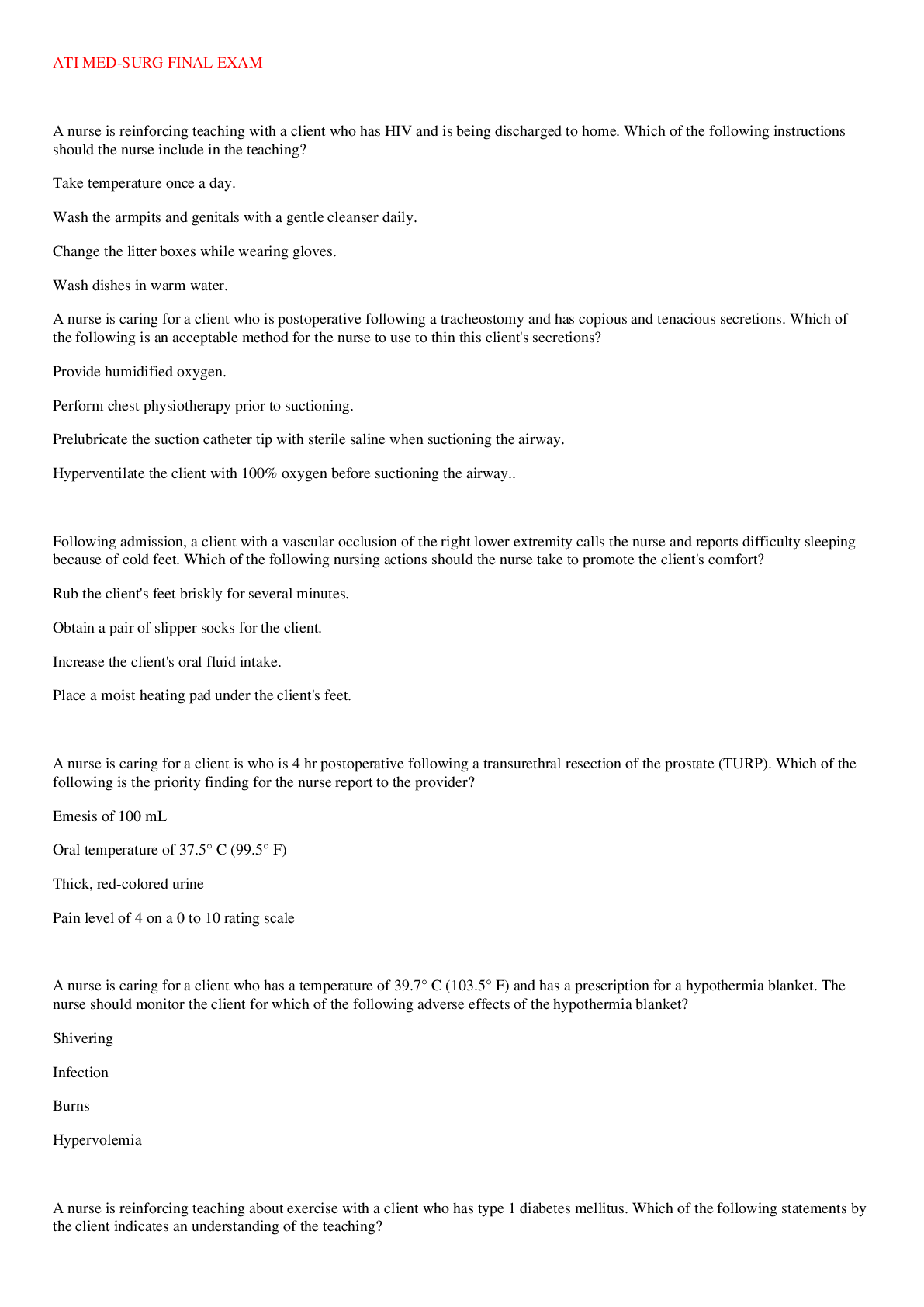*NURSING > QUESTIONS and ANSWERS > ATI Practice Questions Mental Health Exam 3,100% CORRECT (All)
ATI Practice Questions Mental Health Exam 3,100% CORRECT
Document Content and Description Below
1. A nurse observes a client who has OCD repeatedly applying, removing, and then reapplying makeup. The nurse identifies that repetitive behavior in a client who has OCD is due to which of the followi... ng? a. Narcissistic behavior b. Fear of rejection from staff c. Attempt to reduce anxiety d. Adverse effect of antidepressant medication 2. A nurse is caring for a client who is experiencing a panic attack. Which of the following actions should the nurse take? a. Discuss new relaxation techniques b. Show the client how to change his behavior c. Distract the client with a T.V. show d. Stay with the client and remain quiet 3. A nurse is assessing a client who has generalize anxiety disorder. Which of the following findings should the nurse expect? (SATA) a. Excessive worry for 6 months b. Impulsive decision making c. Delayed reflexes d. Restlessness e. Need for reassurance 4. A nurse is planning care for a client who has body dysmorphic disorder. Which of the following actions should the nurse plan to take first? a. Assessing the client risk for self-harm b. Instilling hope for positive outcomes c. Encouraging the client to participate in group therapy sessions d. Encouraging the client to participate in treatment decisions 5. A nurse is caring for a client who has acute stress disorder is experiencing severe anxiety. Which of the following statements actions should the nurse make? a. “Tell me about how you are feeling right now” b. “You should focus positive things in your life to decrease your anxiety” c. Why do you believe you are experiencing anxiety” d. “Let’s discuss the medications your provider is prescribing to decrease your anxiety” Chapter 12: Trauma and Stress Related Disorders 1. A nurse working on an acute MH unit is caring for a client who has PTSD. Which of the following findings should the nurse expect? (SATA) a. Difficulty concentrating on tasks b. Obsessive need to talk about the traumatic event c. Negative self-image d. Recurring nightmares e. Diminished reflexes 2. A nurse is involved in a serious and prolonged mass causality incident in the ED. Which of the following strategies should the nurse use to help prevent developing trauma-related disorder? (SATA) a. Avoid thinking about the incident when it is over b. Take breaks during the incident for food and water c. Debrief with others following the incident d. Hold emotions in check in the days following the incident e. Take advantage of offered counseling 3. A nurse is collectingan admission hx for a client who has acute stress disorder (ASD). Which of the following information should the nurse expect to collect? a. The client remembers many details about the traumatic incident b. The client expresses heightened elation about what is happening c. The client states he first noticed manifestations of the disorder 6 weeks after the traumatic incident occurred d. The client expresses a sense of unreality about the traumatic incident 4. A nurse is caring for a client who has derealization disorder. Which of the following findings should the nurse identify as an indication of derealization? a. The client explains that her body seems to be floating above ground b. The client has the idea that someone is trying to kill her and steal her money c. The client states that the furniture in the room seems to be small and far away d. The client cannot recall anything that happened during the past 2 weeks 5. A nurse in an acute MH facility is planning care for a client who has dissociative fugue. Which of the following interventions should the nurse add to the plan of care? a. Teach the client to recognize how stress brings on the personality change in the client b. Repeatedly present client with new information about past events c. Make decisions for the client regarding routine daily activities d. Work the client on grounding techniques Chapter 19: Eating Disorders 1. A nurse is preparing to obtain a nursing history from a client who has a new diagnosis of anorexia nervosa. Which of the following questions should the nurse include in the assessment? (SATA) a. “What is your relationship with your family?” b. “Why do you want to lose weight?” c. “Would you describe your current eating habits?” d. “At what weight do you believe you will look better?” e. “Can you discuss your feelings about your appearance?” 2. A nurse is caring for an adolescent client who has anorexia nervosa with recent rapid weight loss and a current weight of 90lb. Which of the following statements indicates the client is experiencing the cognitive distortion of catastrophizing? a. “Life isn’t worth living if I gain weight” b. “Don’t pretend like you don’t know how fat I am” c. “If I could be skinny, I know I would be popular” d. “When I look in the mirror, I see myself as obese” 3. A nurse is performing an admission assessment of a client who has bulimia nervosa with purging behavior. Which of the following is an expected finding? a. Amenorrhea b. Hypokalemia c. Mottling of the skin d. Slightly elevated body weight e. Presence of lanugo on the face 4. A nurse on an acute care unit is planning care for a client who has anorexia nervosa with binge eating and purging behavior. Which of the following nursing actions should the nurse include in the clients plan of care? a. Allow the client to select preferred meal times b. Establish consequences for purging behavior c. Provide the client with a high-fat diet at the start of treatment d. Implement one-to-one observation during meal times 5. A nurse is caring for a client who has bulimia nervosa and has stopped purging behavior. The client tells the nurse that she is afraid she is going to gain weight. Which of the following responses should the nurse make? a. “Many clients are concerned about their weight. However, the dietician will ensure that you don’t get too many calories in your diet” b. “Instead of worrying about your weight, try to focus on other problems at this time” c. “I understand you have concerns about your weight, but first, lets’ talk about your recent accomplishments d. “You are not overweight, and the staff will ensure that you do not gain weight while you are in the hospital. We know that is important to you” Chapter 21: Medications for Anxiety, Trauma, and Stressor-Related Disorders 1. A nurse is working in a mental health clinic is providing teaching to a client who has a new prescription for Diazepam for generalize anxiety disorder. Which of the following information should the nurse provide? a. Three to six weeks of treatment is required to achieve therapeutic benefit b. Combing alcohol with Diazepam will produce paradoxical response c. Diazepam has a lower risk for dependence than other anxiety medications d. Report confusion as a potential indication of toxicity 2. A nurse is working in an ED is caring for a client who has benzodiazepine toxicity due to an overdose. Which of the following actions is the nurses priority? a. Administer Flumazenil b. Identify the clients level of orientation c. Infuse IVFs d. Prepare the client for a gastric lavage 3. A nurse is caring a client is to beginning to take Fluoxetine for treatment of generalized anxiety disorder. Which of the following statement indications the client understand the use of this mediation? a. “I will take the medication at bedtime” b. “I will follow a low sodium diet while taking this medication” c. “I will need to this mediation discontinue slowly” d. I will be at risk for weight loss with long term use of this medication 4. A nurse is assessing a client 4 hour after receiving an initial dose of fluoxetine. Which of the following findings should the nurse report to the provider as indications of serotonin syndrome? (SATA) a. Hypothermia b. Hallucinations c. Muscular flaccidity d. Diaphoresis e. Agitation 5. A nurse is caring for a client who takes Paroxetine to treat PTSD. Client states that he grinds this teeth at night which causes pain in his mouth. The nurse should identify which of the following interventions as possible measures to manage the client bruxism? a. Concurrent administration of buspirone b. Administration of a different SSRI c. Use of a mouth guard d. Changing to a different class of antianxiety medication e. Increase the dose of Paroxetine Chapter 29: Crisis Management 1. A nurse is conducting chart reviews at MH facility. Which of the following is example of a client experiencing a maturational crisis? a. Rape b. Marriage c. Severe physical illness d. Job loss 2. A nurse is caring for a client experiencing a crisis. Which of the following medications might the provider might prescribe? (SATA) a. Lithium carbonate b. Paroxetine c. Risperidone d. Haloperidol e. Lorazepam Chapter 30: Suicide 1. A nurse is assessing a client who has major depressive disorder. The nurse should identify which of the following client statements as a comment about suicide? (SATA) a. “My family will be better off if I die” b. “The stress in my life is too much to handle c. “I wish my life is over” d. “I don’t think I can ever be happy again” e. “I’ll kill myself then my problems will go away” 2. A nurse is caring for a client who states “I plan to commit suicide”, which of the following should the nurse identify as the priority? a. Client education and economic background b. Lethality of the method and the availability c. Quality of the clients social support d. Clients insight into the reasons for the decision 3. A nurse is a assisting with the development of protocols to address the increasing number of suicide attempts in the community. Which of the following interventions should the nurse include as a priority intervention? (SATA). a. Conducting a suicide risk screening on all new clients b. Creating a support group for family members of clients who complete suicide c. Educating high school teens about suicide prevention d. Initiating one-on-one observation for a client who has current SI e. Teaching middle school educators about warning indicators about suicide 4. A nurse is caring for a client who is on suicideprecautions. Which of the following interventions should the nurse include intoclients plan of care? a. Assign the client to a private room b. Document the clients behavior every hour c. Allow the client to keep perfume in her room d. Ensure the client swallows medication 5. A nurse is conducting a class for a group of newly licensed nurses on caring for clients who are at risk for suicide. Which of the following information should the nurse include in the teaching? a. A clients verbal threat of suicide is attention seeking behavior b. Interventions are ineffective for clients who really want to commit suicide c. Using the term suicide increases the clients risk for suicide d. A no-suicide contract decreases the clients risk for suicide. [Show More]
Last updated: 1 year ago
Preview 1 out of 6 pages
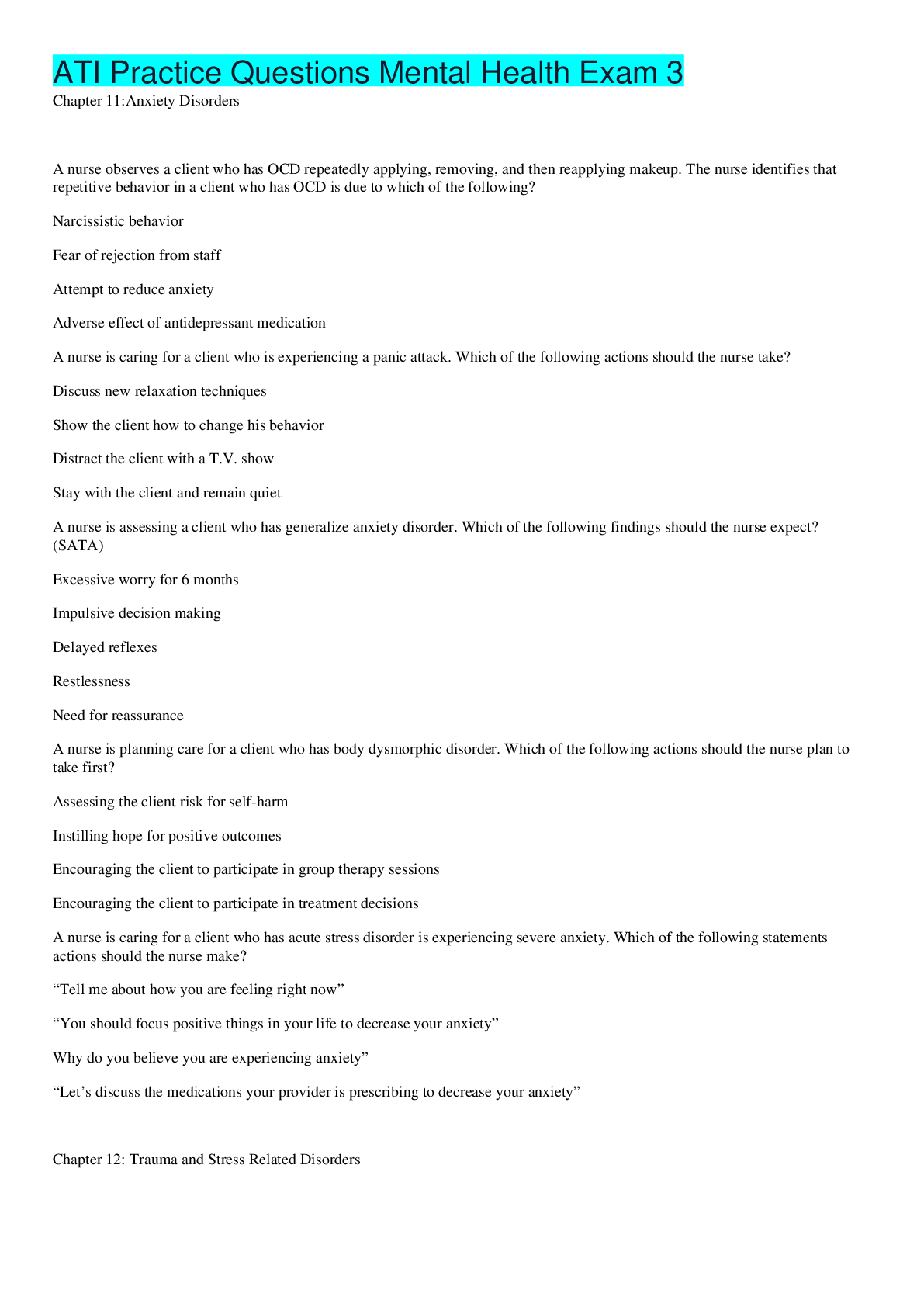
Reviews( 0 )
Document information
Connected school, study & course
About the document
Uploaded On
Dec 03, 2020
Number of pages
6
Written in
Additional information
This document has been written for:
Uploaded
Dec 03, 2020
Downloads
0
Views
47

